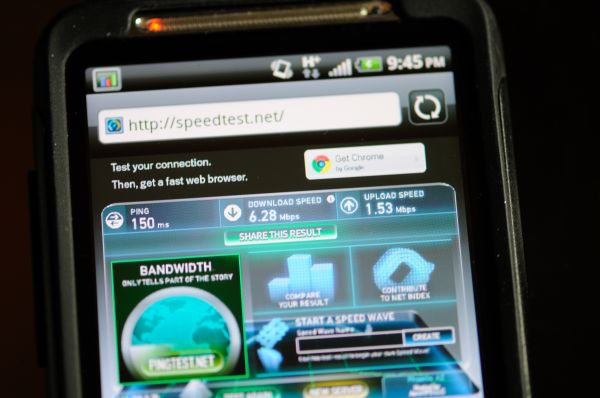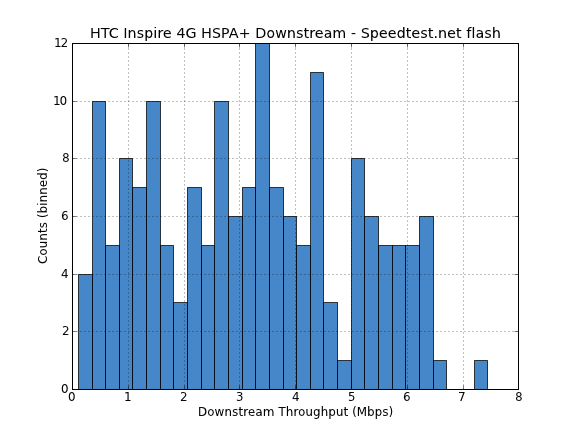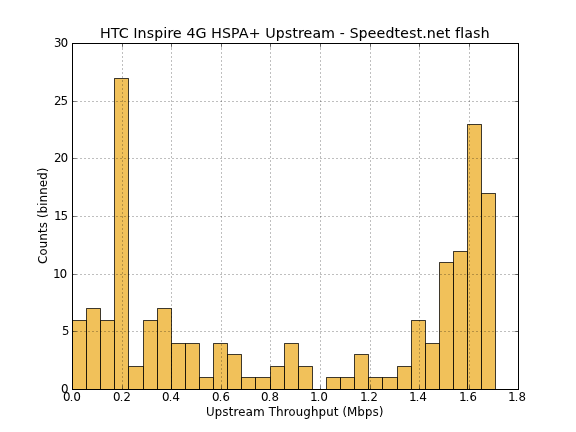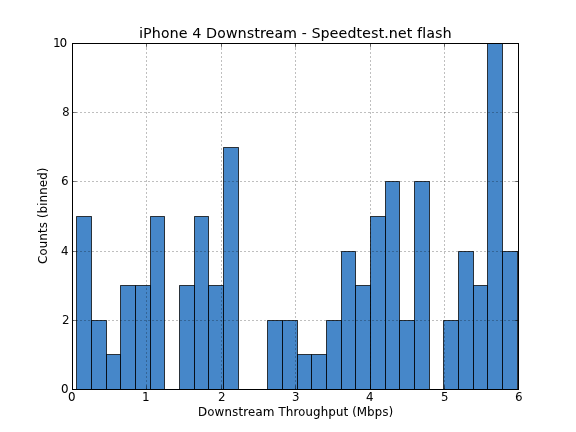AT&T Update Enables HSUPA on Motorola Atrix, HTC Inspire - Our Analysis
by Brian Klug on May 1, 2011 4:25 AM EST- Posted in
- Smartphones
- AT&T
- ATRIX 4G
- HTC Inspire 4G
- HSUPA
- Mobile
With just a day left in April, AT&T made good on its promise to enable HSUPA for its two newest HSPA+ enabled smartphones, the Motorola Atrix and HTC Inspire 4G, before month's end. The two phones originally shipped with HSUPA disabled. As a result upstream throughput was capped at WCDMA rates of 384 kilobits/sec instead of much higher upstream throughput possible with both phones celluar basebands.
The HTC Inspire 4G uses a Qualcomm MSM8255 SoC with a bulit in cellular modem that supports HSPA+ 14.4 Mbps down, 5.76 Mbps up. The Motorola Atrix 4G uses a Tegra 2 SoC and an external Qualcomm MDM6600 which also supports the same HSPA+ rates of 14.4 Mbps down 5.76 Mbps up. In most AT&T markets upstream speeds of around 1.5 Mbps are possible with HSUPA enabled.
The updates bring a few other software improvements beyond enabling HSUPA. On the Atrix, Android is updated to 2.2.2, WiFi hotspots can be created on EDGE, and Yahoo email can be synchronized over WiFi. On the Inspire 4G, email account creation settings are updated and simplified, though unfortunately Android remains at 2.2.1 on the handset. Changelogs for both the Inspire and Atrix can be found at the respective links.
Anand reviewed the Atrix 4G a while back, and I purchased outright an HTC Inspire 4G both to review and use as a daily driver to replace my aging Nexus One. For a while now, enabling HSUPA on the Inspire 4G merely involved editing build.prop if you had root, and likewise XDA Devs enabled HSUPA on the Atrix a few days ago. I've been patiently waiting for HSUPA to be enabled on the official Inspire 4G ROM before diving into a review, since not having HSUPA in the stock ROM has been a major drawback.
I updated the Inspire 4G this morning and immediately set out doing some drive testing to determine what all has changed. My market has been HSPA+ (3GPP release 7) enabled for some time now, which I verified using some AT commands on a Sierra Aircard 308 a few months ago. In addition, I've seen upstream speeds of around 1.5 Mbps on countless devices.
After the update I originally could not get upstream speeds above the 384 kbps WCDMA rate on the Inspire 4G. After tinkering, I was able to get HSUPA speeds after a factory data reset and a number of battery pulls. I've seen mixed reports in forums with people having immediate success and some hesitation similar to what I experienced.
My original intention was to show before and after speeds on the Inspire to illustrate the difference. Unfortunately, in my haste to figure out why I couldn't get any HSUPA, I nuked my tests from before the update with the factory reset. Having HSUPA enabled has not only improved upstream speeds, it also has improved how fast downstream throughput scales. I'm not sure whether the offical buld.prop also has changed the HSDPA category, but downstream is likewise noticeably faster.

One of the best results I've seen thus far from the Inspire 4G after the update
What's curious about the HTC Inspire is how bimodal upstream throughput seems to be. See for yourself in the graphs. I've run 169 tests on the Inspire today all over my local market of Tucson, AZ and generated some plots.
It's easy to see that upstream speeds are much improved on the Inspire. What's puzzling again is that there's a clear double distribution going on, with one cluster of results centered around the WCDMA upstream rate of 384 kbps, and another around the much more typical 1.5 Mbps upstream throughput I see on virtually every other 3G handset I've used on AT&T. It almost seemed like every other test I ran would alternate between upstream throughput of 1.5 Mbps, and then 384 kbps, even in the same position. I took some photos of the Inspire 4G showing this behavior just a minute apart in an area with very good AT&T signal.
HSUPA is definitely enabled, however it seems that there's some other shaping going on which will toss the phone back on just WCDMA for upstream occasionally. I haven't seen this off and on behavior on any other AT&T handset in this market yet. Finally, downstream throughput now occasionally peaks all the way up to over 6 Mbps. It still isn't as fast as LTE's 10 - 20 Mbps, but it's also not bad.
For comparison, you can see the iPhone 4's throughput profile from the last 100 or so tests I've run over the course of months. The iPhone 4's baseband is an Infineon X-Gold 618 with HSDPA 7.2 and HSUPA 5.76 support, and isn't HSPA+ enabled.
Downstream performance on the iPhone 4 is similar to the Inspire, though the Inspire is able to push above 6 Mbps in places I've only seen 5.8 Mbps on the iPhone 4. There's definitely a small clustering of results down near 384 kbps on the iPhone 4, but not nearly as much of a double distribution as what you can see with the Inspire. Obviously the two have different cellular modems, and thus different performance, I'm just not certain how much that difference contributes to the skew in upstream performance.
It's nice that AT&T has updated both the Atrix and Inspire to support the full potential of each's cellular modem, though it took a few months. It will also be interesting to see whether upstream speeds fall below the relatively regular 1.5 Mbps I've become accustomed to seeing on everything from the iPhone 4 to Nexus One.

















20 Comments
View All Comments
solipsism - Sunday, May 1, 2011 - link
I am under the impression that HSPA+ started with Release 7 at 17.6Mbps, not 14.4Mbps.Brian Klug - Sunday, May 1, 2011 - link
Ahh, you're alluding to the wiki page which has changed and now shows that difference ;)So that actually used to be correct.
I used to be under the impression that it was wrong myself for some time, until I both found the original tables in the 3GPP specifications used to create the original UE category tables, and then spoke to Qualcomm about it and learned that 64QAM support is not mandatory in release 7, but optional. Both MSM8x55 and MDM6x00 only support 16QAM, but 3GPP release 7 mandatory features, and are thus HSPA+. There are some newer modems coming out from Qualcomm which do include 64QAM support, however.
So here's the two tables:
http://images.anandtech.com/reviews/gadgets/HTC/In...
http://images.anandtech.com/reviews/gadgets/HTC/In...
which I'd strongly encourage you to check out. The table on that wiki page sort of confuses things.
HSPA+ brings a lot of other things to the table other than adding support for a higher order modulation scheme that doesn't get used much other than when you're very close to the cell center. I believe there's been some drive testing showing it's used ~15% of the time, I'm running my own drive testing on the Samsung Galaxy S 4G which shows a breakdown of what percentage of frames were QPSK, 16QAM or 64QAM. The SGS4G (and probably SGS2) include an ST Ericsson THOR 5730 21 Mbps HSPA+ modem, which to my knowledge is the first shipping one with 64QAM support. We'll probably show the same or similar numbers based on the data I have now, but testing is still ongoing and taking me a lot longer than expected.
I'm getting off topic, but basically most of the mandatory stuff in HSPA+ is actually reduced signaling overhead, faster call setup, and similar under the hood enhancements. To that extent both of these phones are HSPA+ even though they're only 14.4 Category 10 / 16QAM - they support all those mandatory features.
I hope this helps, I've been meaning to bring it up for a long time because I too assumed there was something going on and the switch from HSPA to HSPA+ happened only with 64QAM inclusion.
Take care,
Brian
solipsism - Sunday, May 1, 2011 - link
That cleared much up. Thanks for the thorough reply.xdrol - Sunday, May 1, 2011 - link
There are no mandatory features in Release 7. The only mandatory features for WCDMA devices are in the very first version of the 3GPP standard - all new features of all subsequent releases are optional.You are still right that this is a Rel7 device, as it supports features new in Rel7.
Brian Klug - Sunday, May 1, 2011 - link
That's actually the best way of saying it - if you have release 7 features, you're release 7.I misspoke, thanks for pointing that out. :)
-Brian
EnerJi - Sunday, May 1, 2011 - link
Interesting information.I'm especially curious about the "faster call setup" portion of the standard. Is this something that will be noticeable by the average consumer? Is it significant enough to be testable?
I, for one, would be very curious to see if there's a significant improvement. One of frustrations with current mobile technology is how long it sometimes takes to connect phone calls, and how often the call "fails" before it even rings. It would be great to know whether HSPA+ will improve this situation.
B3an - Sunday, May 1, 2011 - link
Will you be reviewing the Galaxy S2 soon? It's only the best phone ever.Brian Klug - Sunday, May 1, 2011 - link
We definitely will be, just have to wait for Samsung US to send us one ;)-Brian
jjj - Sunday, May 1, 2011 - link
"AT&T Update Enables HSUPA on Motorola Atrix, HTC Inspire - Our Analysis"OK i was curious about the Atrix and started reading.
Finished reading and no Atrix analysis...!
Brian Klug - Sunday, May 1, 2011 - link
Yeah unfortunately we only have the HTC Inspire to analyze, but the update for the Atrix is exactly the same and should show similar performance on the upstream. I'm not sure whether it also has a strange distribution of upstream throughputs, however.-Brian